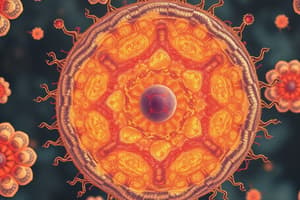Podcast
Questions and Answers
Match the subcellular structure with its function:
Match the subcellular structure with its function:
Nucleus = Contains genetic material in the form of chromosomes that controls the cell's activities Cytoplasm = Gel-like substance where all the chemical reactions occur in the cells Mitochondria = Powerhouse of the cell where cellular respiration takes place Ribosomes = Site where the production of proteins takes place in the cell
Match the organelle with its description:
Match the organelle with its description:
Chloroplast = Contains a green substance called chlorophyll used for photosynthesis Vacuole = Contains cell sap which inflates the cell Cell membrane = Holds the cell together and controls what goes in and out by providing a selective barrier Cell wall = Made up of cellulose and makes the cell wall rigid for support
Match the type of DNA with its location:
Match the type of DNA with its location:
Chromosomal DNA = Contains genetic material and flows in the cell's cytoplasm Plasmid = Small loops of extra DNA used for drug resistance and can be passed between bacteria One long circular loop of DNA = Controls the cell’s activities and replication, floats free in the cytoplasm, not in a nucleus Chromosomes in the nucleus = Contain genetic material and control the cell's activities
Match the cell type with its description:
Match the cell type with its description:
Match the function with its corresponding organelle:
Match the function with its corresponding organelle:
Match the following microscope types with their invention decade:
Match the following microscope types with their invention decade:
Match the following microscope features with their functions:
Match the following microscope features with their functions:
Match the following cell components with their visibility under light microscopes:
Match the following cell components with their visibility under light microscopes:
Match the following microscope types with their characteristics:
Match the following microscope types with their characteristics:
Match the following concepts with their definitions:
Match the following concepts with their definitions:
Flashcards are hidden until you start studying
Study Notes
Cell Structure and Function
- Eukaryotic cells are large and complex, found in animals and plants, and have a subcellular structure with specific functions.
- Prokaryotic cells are simpler and smaller, found in bacteria, and lack a true nucleus.
Subcellular Structure and Function
- Nucleus: contains genetic material in the form of chromosomes, controlling the cell's activities.
- Cytoplasm: gel-like substance where chemical reactions occur.
- Mitochondria: powerhouse of the cell, site of cellular respiration, containing enzymes needed for the reaction.
- Ribosomes: site of protein production in the cell.
- Cell membrane: holds the cell together, controls what goes in and out, and provides a selective barrier with receptor molecules for cell communication.
- Chloroplast: contains chlorophyll, used for photosynthesis.
- Vacuole: contains cell sap, inflating the cell.
- Cell wall: made of cellulose, making the cell wall rigid and providing support.
Prokaryotic Cell Features
- DNA is a long, circular loop that controls the cell's activities and replication, floating free in the cytoplasm.
- Chromosomal DNA: contains genetic material, flowing in the cell's cytoplasm.
- Plasmid: small loops of extra DNA, used for drug resistance and can be passed between bacteria.
Microscopy
- Microscopes use lenses to magnify images, increasing resolution and detail.
- Light microscopes: invented in the 1590s, allowing us to see nuclei and chloroplasts.
- Electron microscopes: invented in the 1930s, allowing us to see smaller structures like mitochondrial internal structure.
- TEMs (Transmission Electron Microscopes): higher magnification and resolution than light microscopes, but not portable, expensive, and complicated to prepare specimens.
Studying That Suits You
Use AI to generate personalized quizzes and flashcards to suit your learning preferences.




